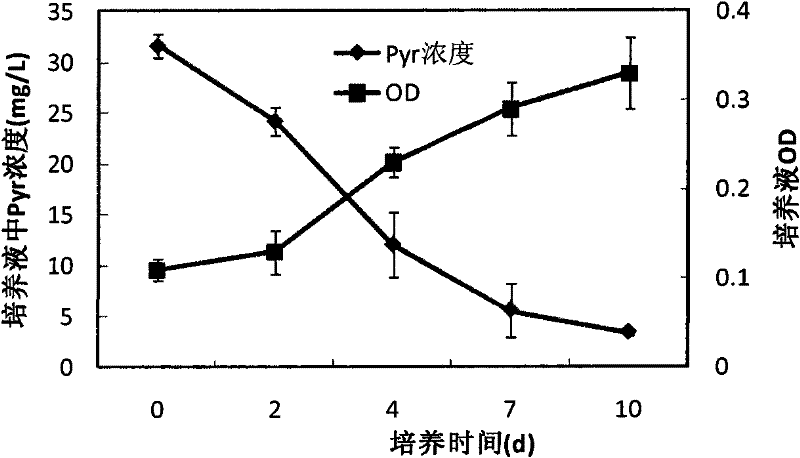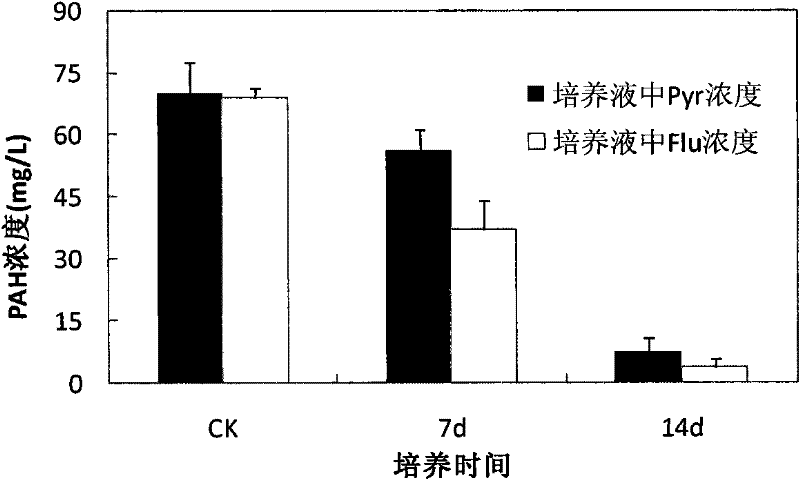Microorganism bacterium agent for degrading polycyclic aromatic hydrocarbon
A microbial agent and polycyclic aromatic hydrocarbon technology, which is applied in the direction of microorganisms, microbial-based methods, biological water/sewage treatment, etc., can solve the problems that the remediation effect of polycyclic aromatic hydrocarbon-contaminated soil has not been reported, and achieve good application prospects.
- Summary
- Abstract
- Description
- Claims
- Application Information
AI Technical Summary
Problems solved by technology
Method used
Image
Examples
experiment example 1
[0039] Experimental Example 1 The experiment of microbial bacterial agent of the present invention degrading polycyclic aromatic hydrocarbon-pyrene (Pyr)
[0040] According to the ratio of the number of live bacteria of Mycobacterium chrysogenum P6 and microacidophilic oligotrophomonas P56 as 1-2:1, a total of 0.5 ml of bacterial liquid of P6 and P56 was inserted into 20 mL of inorganic salt liquid medium (Na 2 HPO 4 .12H 2 O 8.8g, KH 2 PO 4 3.0g, NH 4 NO 3 1.0g, MgSO 4 .7H 2 O0.246g, FeCl 3 0.05g, CaCl 2 0.02g, trace element solution, 2.5ml, distilled water 1000ml. The composition of the trace element solution is: MnSO 4 .2H 2 O 0.06g, H 3 BO 3 0.03g, CoCl 2 .6H 2 O 0.04g, CuCl 2 .2H 2 O 0.01g, NiCl 2 .6H 2 O 0.02g, Na 2 MoO 4 .2H 2 O 0.03g, ZnCl 2 0.05g, pH7, distilled water 1000ml) serum bottle, add 5g / L pyrene acetone solution 0.1ml in advance in the serum bottle, and volatilize the acetone, the final concentration of fluoranthene in the culture medi...
experiment example 2
[0042] Experimental Example 2 The experiment of microbial bacterial agent of the present invention degrading polycyclic aromatic hydrocarbons-pyrene (Pyr) and fluoranthene (Flu) mixture
[0043] Change the concentration of polycyclic aromatic hydrocarbons in the serum bottle, add 0.1ml of acetone solution of 5g / L fluoranthene; at the same time, add 0.1ml of acetone solution of 5g / L pyrene, and volatilize the acetone, so that the medium contains pyrene at the same time and fluoranthene, their final concentrations were 100mg / L, respectively, and cultured on a shaker at 30°C in the dark after being inserted into the degrading strain, samples were taken on the 7th and 14th day, and the remaining polycyclic aromatic hydrocarbons in the culture medium were determined. The negative control CK is only added pyrene or fluoranthene to the inorganic salt medium without inoculation.
[0044] The result is as figure 2 As shown, the addition of fluoranthene did not affect the degradation ...
PUM
 Login to View More
Login to View More Abstract
Description
Claims
Application Information
 Login to View More
Login to View More - R&D
- Intellectual Property
- Life Sciences
- Materials
- Tech Scout
- Unparalleled Data Quality
- Higher Quality Content
- 60% Fewer Hallucinations
Browse by: Latest US Patents, China's latest patents, Technical Efficacy Thesaurus, Application Domain, Technology Topic, Popular Technical Reports.
© 2025 PatSnap. All rights reserved.Legal|Privacy policy|Modern Slavery Act Transparency Statement|Sitemap|About US| Contact US: help@patsnap.com


